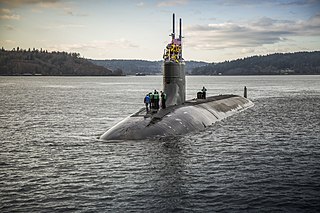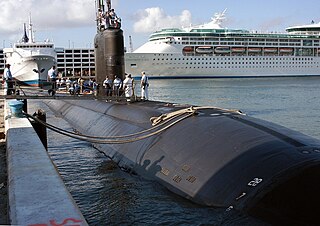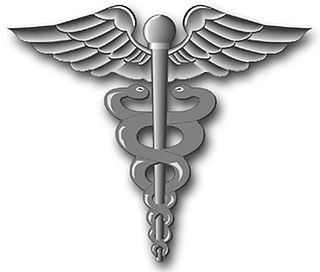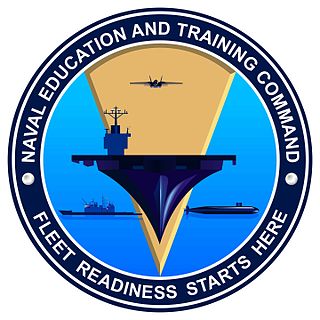The United States Armed Forces are the military forces of the United States. The armed forces consists of six service branches: the Army, Marine Corps, Navy, Air Force, Space Force, and Coast Guard. All six armed services are among the eight uniformed services of the United States.

Naval Submarine Base New London is the primary United States Navy East Coast submarine base, also known as the "Home of the Submarine Force." It is located in Groton, Connecticut directly across the Thames River from its namesake city of New London.
BAP Pacocha (SS-48) was a submarine of the Marina de Guerra del Perú named for the 1877 Battle of Pacocha, in which the Peruvian ironclad Huascar clashed with the Royal Navy. Formerly USS Atule (SS-403), a Balao-class submarine with a GUPPY IA upgrade, she had been sold to Peru and commissioned on 28 May 1974. She was rammed and sunk by a fishing trawler on 26 August 1988.
The Submarine Warfare Insignia are worn by qualified submariners.
The Fleet Marine Force Warfare Insignia, also known as the Fleet Marine Force badge or FMF pin, are three military badges of the United States Navy which are issued to those U.S. Navy officers and sailors who are trained and qualified to perform duties in support of the United States Marine Corps. There are currently three classes of the Fleet Marine Force pin, being that of enlisted, officer, and chaplain.

USS Connecticut (SSN-22) is a Seawolf-class nuclear powered fast attack submarine operated by the United States Navy. Connecticut is the fifth active United States Ship to be named for the U.S. state of Connecticut, going back to 1776. The contract to build her was awarded to the Electric Boat Division of General Dynamics Corporation in Groton, Connecticut, on 3 May 1991 and her keel was laid down on 14 September 1992. She was launched on 1 September 1997, sponsored by Patricia L. Rowland, wife of the Governor of Connecticut, John G. Rowland, and commissioned on 11 December 1998.

USS Jacksonville (SSN-699), a nuclear powered Los Angeles-class attack submarine, is the only vessel of the United States Navy to be named for Jacksonville, Florida.

USS Miami (SSN-755) was a Los Angeles-class submarine of the United States Navy. She was the third vessel of the U.S. Navy to be named after Miami, Florida. Miami was the forty-fourth Los Angeles-class (688) submarine and the fifth Improved Los Angeles-class (688I) submarine to be built and commissioned. The contract to build her was awarded to the Electric Boat division of General Dynamics Corporation in Groton, Connecticut, on 28 November 1983, and her keel was laid down on 24 October 1986. She was launched on 12 November 1988 and commissioned on 30 June 1990 with Commander Thomas W. Mader in command.
There are three major types of submarines in the United States Navy: ballistic missile submarines, attack submarines, and cruise missile submarines. All submarines currently in the U.S. Navy are nuclear-powered. Ballistic missile submarines have a single strategic mission of carrying nuclear submarine-launched ballistic missiles. Attack submarines have several tactical missions, including sinking ships and subs, launching cruise missiles, and gathering intelligence. Cruise missile submarines perform many of the same missions as attack submarines, but with a focus on their ability to carry and launch larger quantities of cruise missiles than typical attack submarines.

Insignias and badges of the United States Navy are military badges issued by the United States Department of the Navy to naval service members who achieve certain qualifications and accomplishments while serving on both active and reserve duty in the United States Navy. Most naval aviation insignia are also permitted for wear on uniforms of the United States Marine Corps.

The United States Navy Reserve (USNR), known as the United States Naval Reserve from 1915 to 2005, is the Reserve Component (RC) of the United States Navy. Members of the Navy Reserve, called Reservists, are categorized as being in either the Selected Reserve (SELRES), the Training and Administration of the Reserve (TAR), the Individual Ready Reserve (IRR), or the Retired Reserve.

A hospital corpsman is an enlisted medical specialist of the United States Navy, who may also serve in a U.S. Marine Corps unit. The corresponding rating within the United States Coast Guard is health services technician (HS).

The Naval Education and Training Command (NETC) is an enterprise level shore command of the United States Navy with more than 19,000 military and staff personnel at more than 1,640 subordinate activities, sites, districts, stations, and detachments throughout the world.

Fire controlman is a United States Navy occupational rating. Often confused with being fireman on board a ship, FC's actually operate advanced weapons systems, whereas Damage Controlman (DC) are actually the shipboard firefighters.

Many women have served in the United States Navy for over a century. As of 2020, there were 69,629 total women on active duty in the US Navy, with 11,076 serving as officers, and 58,553 enlisted. Of all the branches in the US military, the Navy has the second highest percentage of female active duty service members with women making up 20% of the US Navy in 2020.

USS Michael Murphy (DDG-112) is the 62nd ship of the Arleigh Burke class of guided missile destroyers in the United States Navy. She is named for Medal of Honor recipient Lieutenant Michael P. Murphy (1976–2005). Murphy was posthumously awarded the Medal of Honor for his actions during Operation Red Wings in Afghanistan in June 2005. He was the first sailor awarded the Medal of Honor since the Vietnam War. The ship's name was announced by Secretary of the Navy, Donald C. Winter on 7 May 2008. The ship was christened on 7 May 2011, Murphy's birthday, by her sponsor Maureen Murphy, Michael Murphy's mother. The ship is part of Destroyer Squadron 31 of Naval Surface Group Middle Pacific.

Nuclear Power School (NPS) is a technical school operated by the U.S. Navy in Goose Creek, South Carolina as a central part of a program that trains enlisted sailors, officers, KAPL civilians and Bettis civilians for shipboard nuclear power plant operation and maintenance of surface ships and submarines in the U.S. nuclear navy. As of 2020 the United States Navy operates 98 nuclear power plants, including 71 submarines, 11 aircraft carriers, and three Moored Training Ships (MTS) and two land-based training plants. NPS is the centerpiece of the training pipeline for U.S. Navy nuclear operators. It follows initial training at Nuclear Field "A" School or a college degree, and culminates with certification as a nuclear operator at one of the Navy's two Nuclear Power Training Units (NPTU).

The United States Navy job rating of electronics technician (ET) is a designation given by the Bureau of Naval Personnel (BUPERS) to enlisted members who satisfactorily complete initial Electronics Technician "A" school training.
The United States Navy Nuclear Propulsion community consists of Naval Officers and Enlisted members who are specially trained to run and maintain the nuclear reactors that power the submarines and aircraft carriers of the United States Navy. Operating more than 80 nuclear-powered ships, the United States Navy is currently the largest naval force in the world.

The Master-at-Arms (MA) rating is responsible for law enforcement and force protection in the United States Navy—equivalent to the United States Army Military Police, the United States Marine Corps Military Police, the United States Air Force Security Forces, and the United States Coast Guard's Maritime Law Enforcement Specialist. It is one of the oldest ratings in the United States Navy, having been recognized since the inception of the U.S. Navy.















